St Andrew's Presbyterian Church
Newcastle
Hill & Son 1890, 3m., 23 sp.st., mechanical
Historical and Technical Documentation by Kelvin Hastie
© OHTA 2005 (last updated October 2005)
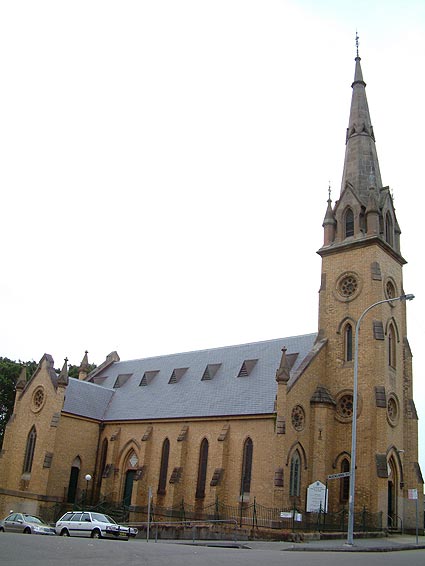
© Pd L 2005
The first organ used by Newcastle Presbyterians was installed in the Watt Street Church in 1867, this being later transferred to the present church until displaced by the present magnificent Hill & Son organ. [2] The Hill was ordered in 1890 and arrived in 1892 as job number 2079, although during the 1997 restoration Mark Fisher found the pedal coupler assembly and Open Diapason 16ft rollerboard clearly marked as 2093 (the job number of the organ now at Christ Church St Laurence in Sydney), while the keyboard frames were found to have paper inscription with labelling for 2094 (for the organ formerly in the Manly Presbyterian Church). Interesting theories to explain the apparent mix up have been postulated; most centre on storage errors prior or during shipment from the firm’s London works. [3]
The organ was documented in 1981 and 1983 by John Stiller, who noted that the organ was essentially intact, although tuning slides had been fitted to most open metal flue pipes, a Voix Celeste (and associated pneumatic stop action) had been added on a clamp to the Swell, a tremulant had been added, the Choir enclosed and minor modifications made to the operation of the bellows. [4] The church received a small grant from the NSW Heritage Office in 1995 to assist the restoration undertaken by Pipe Organ Reconstructions Pty Ltd, with Kelvin Hastie as consultant.
The restoration consisted of considerable site work (including a new chamber floor), repolishing of the case timberwork and the restoration and touching-up of the façade pipes by Erica Harrison of Dundas. The surviving ivories of the Choir manual were cleaned, with recycled replacements provided for worn notes in the middle of the compass. Missing stop domes and ferrules were replaced and a bellows telltale was restored to the console. All action components were restored with new leather buttons and bushings provided: tracker end bindings and wires were cleaned and retained. Additional spacer combs were fitted to the Swell and Choir actions to protect the trackers. The Great, Swell and Pedal chests were fully restored and it was noted with interest that the tables of both Great and Swell were divided into sections with leather joins to reduce warping and shrinking from climatic variation. The bellows (previously divided into two sections) was restored to double rise. All pipework was cleaned and washed and original brass reed tongues retained. The unoriginal choir box was removed to enable better balance and tonal egress in relation to the other divisions. Although the Hill order book indicates that the voicing was to be “quiet”, the firm obviously ignored this request, as the instrument possesses all of the bold clarity associated with other surviving Hill instruments.
[5]
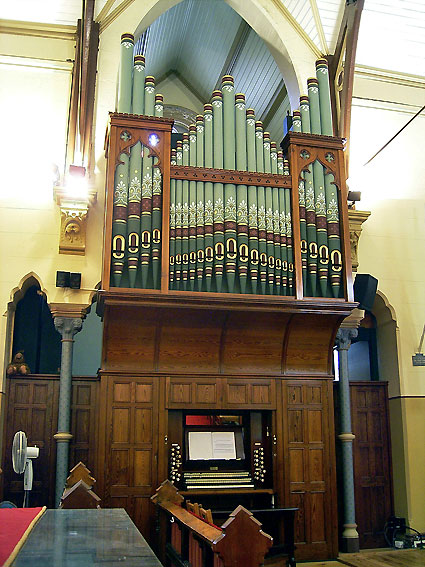
Hill & Son 1890 (3/23 mechanical)
| GREAT Bourdon Open Diapason Hohl Flute Gamba Principal Wald Flute Twelfth Fifteenth Mixture SWELL Open Diapason Stopped Diapason Salicional Voix Celeste Dulcet Cornopean Oboe Tremulant § CHOIR Lieblich Gedeckt Dulciana Gemshorn Suabe Flute Clarionet PEDAL Open Diapason Bourdon |
16 Ft. 8 Ft. 8 Ft. 8 Ft. 4 Ft. 4 Ft. 3 Ft. 2 Ft. 3 RKS 8 Ft. 8 Ft. 8 Ft. 8 Ft. 4 Ft. 8 Ft. 8 Ft. 8 Ft. 8 Ft. 8 Ft. 4 Ft. 8 Ft. 16 Ft. 16 Ft. |
+ * ¶ TC TA# |
COUPLERS
Swell to Great
Swell to Choir
Great to Pedal
Swell to Pedal
Choir to Pedal
3 composition pedals for Great
2 composition pedals for Swell
Mechanical action throughout
Compass 56/30
Hitch-down swell lever
No. of pipes = 1,302
Pitch a1 = 445.5 Hz at 190 C
Wind pressure (in 1981) = 78 mm (3”)
+ C-B from Hohl Flute
* C-B from Stopped Diapason
¶ Added by Griffin & Leggo, 1912
§ Not original
Mixture composition:
C - F#0 : 17.19.22
g0 - a#1 : 15.19.22
b1 - g3 : 8.12.15
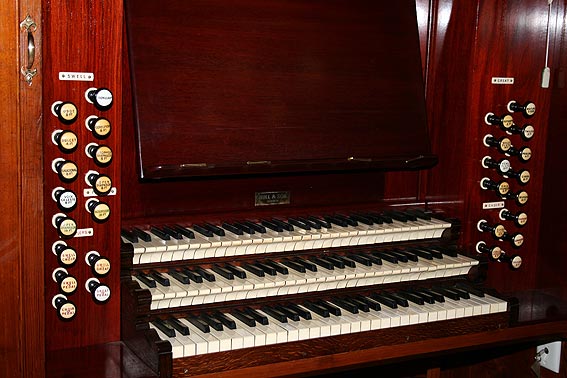
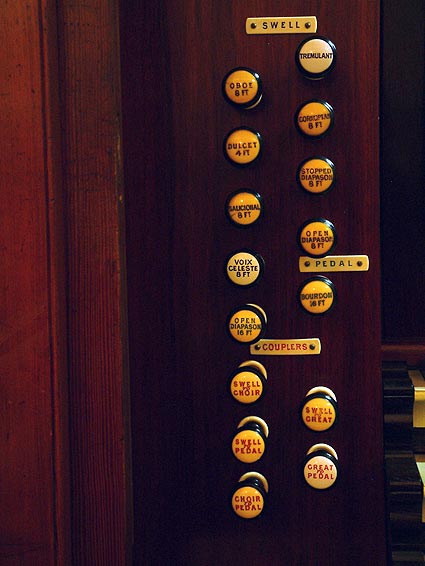 |
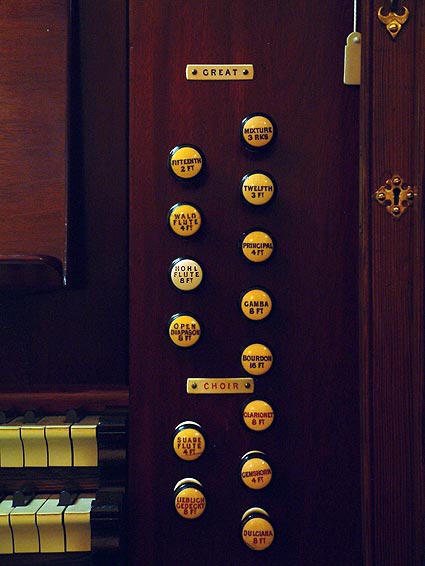 |
|
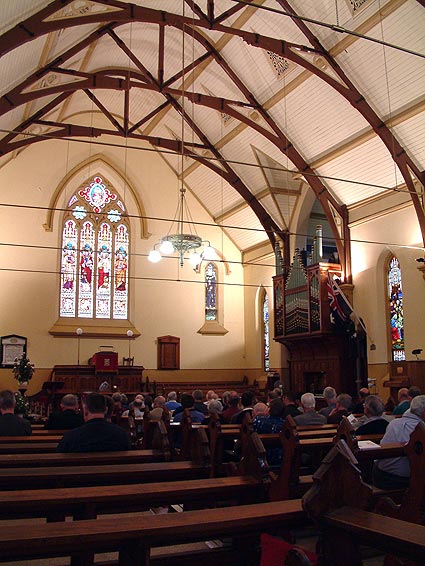 |
||
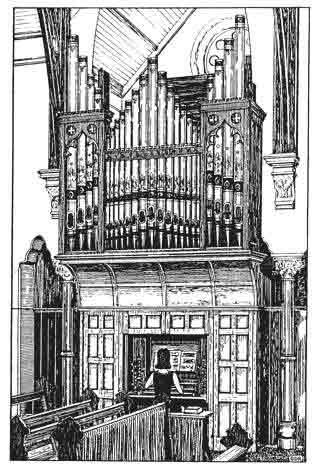
Hill & Son, London, 1890
St Andrew’s Presbyterian Church, Newcastle
(drawing by Graeme Rushworth)
[1]
Barry Maitland and David Stafford, Architecture Newcastle. Newcastle, NSW: RAIA (Newcastle Division), 1997, 12-13 and 82.
[2] Pers. Comm. Graeme Rushworth to Kelvin Hastie August 2005.
[3] Kelvin Hastie, “Restoration: the Hill & Son Organ of St Andrew’s Presbyterian Church, Newcastle”, Sydney Organ Journal 28/3 (Spring 1997): 27-30.
[4] John Stiller, “St Andrew’s Presbyterian Church, Newcastle NSW. Detailed Documentation of Pipe Organ built by Hill & Son 1890”. Organ Historical Trust of Australia, 1981 and 1983.
[5] Hastie, “Restoration”, ibid.